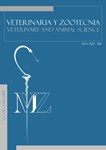Authors
Abstract
The effect on growth and survival when providing a commercial diet with 32% of crude protein, spirulina (S. platensis) and Artemia (A. franciscana) as unique diet of first feeding, was studied in post-larvae Amazonian Shad (Brycon melanopterus) in the feeding laboratory of the Amazonian Experimental Center, Corpoamazonia. An evaluation of 3,600 post-larvae with a mean weight of 1.6±0.48 mg and length of 5.3±0.10 mm was carried out. The post-larvae were confined in aquariums and divided into three treatments with three replicates, as follows: control (commercial balanced diet supplemented in 15% biomass proportion); treatment 1 (spirulina (S. platensis) distributed at a 4,000 to 5,000 cells/post-larvae rate); treatment 2 (brine shrimp, A. franciscana, supplied at 10 nauplii/post-larvae rate). The food was distributed five times a day during a period of 15 days; statistically significant survival differences were observed. The best result was recorded in treatment 2 with 48% survival rate in relation to the control treatment and treatment 1 with 13% and 22%, respectively. Meaningful, differences in the weight and length increase were also registered, and the result presented show that the treatment 2, with 5.4mg of weight, and 8.5 mm length was the best. While the control and treatment 1 presented 2.6 mg of weight and 4.9 mm of length, and 3.2 mg of weight and 5.1 mm of length, respectively. The results show that the inclusion of brine shrimp is an alternative for the production of fry Amazonian shad (B. melanopterus) because it improves the productivity and profitability rated during the post-larva stage.
Keywords
References
Atencio, V.; Farid, R.; Aristizábal, R. Desarrollo y larvario de Dorada (Brycon sinuensis). Montería. Colombia. MVZ Universidad de Córdoba, v.10, p. 613-614, 2006.
Atencio, V.; Zaniboni, E.; Pardo, S. et al. Influência da primeira alimentação na larvicultura e alevinagem do yamú (Brycon siebenthalae) (Characidae). Animal Sciences Maringá, v.25, n.1, p.61-64, 2003.
Ceccarelli, P. Canibalismo em larvas de matrinxã (Brycon cephalus Gunter, 1969). Botucatu: UNESP, Dissertação (Mestrado em Ciência Biológicas) – Universidad Estadual Paulista, Instituto de Biociências de Botucatu,1997; 92 p.
De la Cruz, J. Producción de quistes de (Artemia franciscana) (Kellog, 1906) bajo condiciones controladas y determinación de su calidad con fines acuícolas. Facultad de ciencias marinas. 1. ed. Colima, México: Centro Editorial Universidad de Colima, 1999. 5p.
García, A. Valor nutricional de los quistes de Artemia y su uso como fuente de proteína en dietas artificiales para larvas de peces. In: V Simposium Internacional de Nutrición Acuícola – CIAD. 2000, Mazatlán, México. Memorias Centro de Investigación en Alimentación y Desarrollo; 2000.289-290p.
Gallardo, P. Alimentación planctónica de larvas de camarón blanco (Pennaeus vannanei). PastoColombia: Universidad de Nariño, 1994. 62- 120p. Tesis (Ingeniero en producción Acuícola).
Lima, F.; Froese, R. Catalog of fishes. Eschmeyer. California. Academy of sciences. FISHBASE: Brycon melanopterus). 2005. Disponible en: http:// www.fishbase.org/Summary/SpeciesSummary. CFM. Accesado en: 05/02/2006.
Palacios, P. Evaluación comparativa de dos estimulantes de crecimiento tipo probiótico y prebiótico en el levante y ceba del Sábalo Amazónico. (Brycon melanopterus Cope 1872), en el Centro Experimental Amazónico. Pasto, Colombia: Universidad de Nariño, 2007. 36- 120p.
Tesis (Ingeniero en Producción Acuícola). Piovezan, U. Efeito da dieta na sobrevivência de larvas de Piracanjuba (Brycon orbignyanus) – CAUNESP. En anais do Primer Seminário sobre Criação de espécies do género Brycon. Pirassununga, Brasil: Cepta, 1994: 18 – 21 p.
Pedreira, M.; Tavares, L.H.; Silva, R. Influência do formato do aquário na sobrevivência e no desenvolvimento de larvas de matrinxã (Brycon cephalus) (Osteichthyes, Characidae). Revista Brasileira Zootecnia, v.35, n.2, 2006: 329-333 p.
Woynarovich, E.; Sato, J. Special rearing of larvae and post-larvae of matrinchã (Brycon lundii) and dourado (Salminusbrasiliensis). En: Harvey B.; Caroldfeld J. EDS Workshop on larval rearing of finfish. Pirassununga, Brasil: Cida/Casafa/ Icsu, 1990:134 p.

 PDF (Español)
PDF (Español)
 FLIP
FLIP










